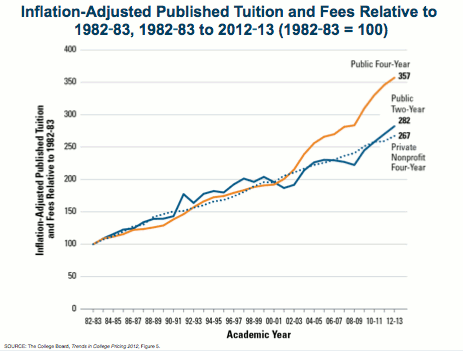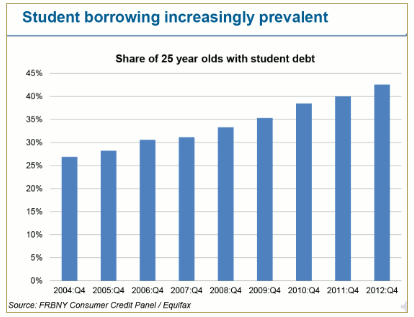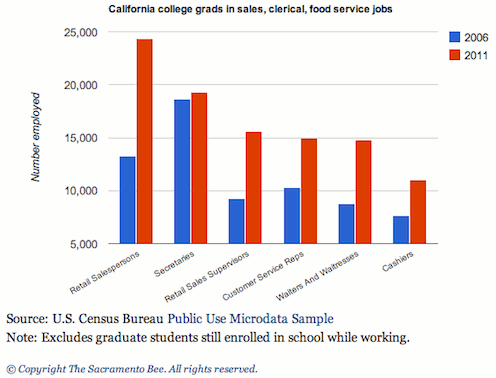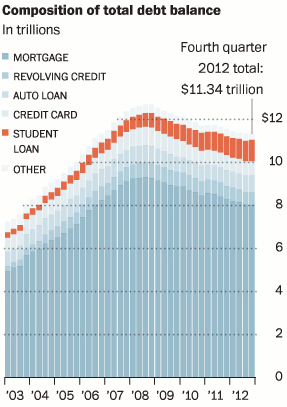We’ve been hearing questions from increasing numbers of families about paying for college, as we also posted earlier. Many of the families asking questions are professionals, college educated, with two incomes and making the same dollar figure of salary as past years, but find these same dollars aren’t stretching as far as in the past. The chart below may shed some light on why income, despite nominal growth (the red line) or the numerical amount, the ability to afford one’s current standard of living is requiring more income, as the blue line represents the negative growth in purchasing power of family’s income.

At the same time that cost of living is increasing, college tuition continues rising, 357% since 1982-83, as explained in the chart below from the College Board. The demand for college education is increasing, as family’s continue believing that a college degree will merit a higher and more stable standard of living. So, colleges need to expand to meet the increase in demand and have raised fees. Also, states challenged by the recession with less tax revenues, are giving less money per student to public colleges forcing families to shoulder a greater amount of the costs of college.

The decreasing ability of a family’s income to afford increasing costs of living and annually rising tuition can explain some of the why families may be concerned about paying for college. So, households may be financing their current day-to-day expenses with consumer debt, which is currently $11.34 trillion:
Chart Source: Federal Reserve Bank of New York Consumer Credit Panel; Equifax. The Washington Post. Published on March 22, 2013
And, with average household debt over 90% of disposable income, or income remaining after taxes as shown below, parents may be hesitant to take on additional debt to finance an education.

Source; The Federal Reserve, Credit: Lam Thuy Vo/NPR
As a result, student loans are rising, as seen below. The average total student debt for the Class of 2012 college graduates is $26,600, according to the Institute for College Access & Success’ Project on Student Debt. (For more on student debt, see our previous post):

Student debt is only as valuable, as getting a high enough paying job to afford the debt payments and other costs of living–which is a driving factor for students and families to enroll in college in the first place. According to a recent report of the Federal Reserve on March 22, job growth has been greatest in low wage and temporary work. 50% of newly created jobs have been in low wage sectors, like retail and restaurant service, while 25% of employment increases have been in temporary and part time work, where employees aren’t guaranteed benefits or upward mobility to earn more eventually. For recent college graduates, low wage jobs, temporary or part time work may represent an “under-employment”, given their skills and training.

Also, with lower wages and temporary or part time employment, recent college graduates may not be able to make payments on their student loans, as see below. An increasing number of young people are delinquent on their student loans, and the Federal Government is spending $1.4 billion to collect delinquent student loans.

Chart Source: Federal Reserve Bank of New York Consumer Credit Panel; Equifax. The Washington Post. Published on March 22, 2013
The current economic conditions for household income, increasing college tuition, as well as employment outlook for recent college graduates, may be addressed with more deliberation in choosing colleges for application. The past precedant of following mom and dad to their alma mater or deciding to apply to only brand name colleges may not fit the student’s educational needs, nor the family pocketbook. Families may also confront the increases in college costs and stagnant household income with greater fiscal planning, as we discussed in our six part series. From Senior families faced with college enrollment decisions by May 1 to middle school families starting to learn about the college admissions process, there are steps to take that can relieve the pressure of paying for college, without going bankrupt.




